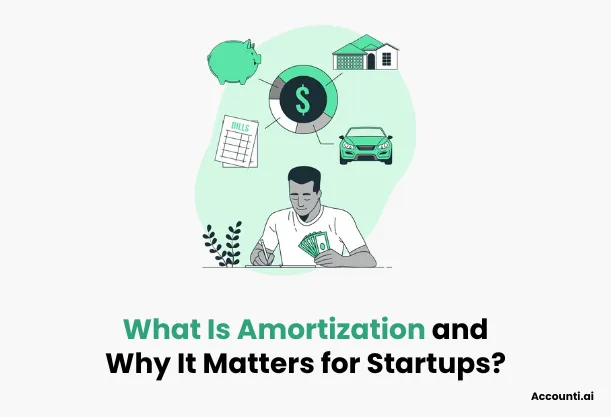
What Is Amortization in Accounting? Why It’s Crucial for Startups
In the fast-paced world of startups, financial management is crucial. Amidst all the jargon, one term that’s often tossed around is amortization. But what exactly does it mean, and how can understanding it benefit your business?
Amortization is more than just an accounting term—it’s a strategic tool that can help startups manage their finances, improve cash flow, and even appeal to investors. In this article, we’ll dive into what amortization means, how it works, and the many benefits it can bring to your startup’s financial health.
What Is Amortization?
At its core, amortization refers to the gradual reduction of a loan or an intangible asset over time. In accounting terms, it specifically relates to spreading the cost of an intangible asset across its useful life. Intangible assets might include patents, trademarks, or copyrights, and unlike physical assets, they don’t have a tangible presence but are often just as valuable.
In simpler terms, amortization is about allocating costs over time. Let’s break it down further:
How Is Amortization Different from Depreciation?
While both amortization and depreciation involve distributing costs over time, they’re not the same. Here’s a quick comparison:
- Depreciation: Applies to tangible assets (e.g., equipment, vehicles)
- Amortization: Applies to intangible assets (e.g., patents, licenses)
Think of depreciation as the gradual “aging” of physical items, while amortization handles the “aging” of non-physical, intangible assets.
How Amortization Works in Accounting
To understand how amortization works, imagine you’ve acquired a patent for a revolutionary software idea. Let’s say the patent cost $100,000, and it has a useful life of 10 years.
Instead of accounting for the $100,000 as a one-time expense, amortization spreads this cost evenly over the 10-year period. This allows for more accurate tracking of expenses and prevents significant one-time costs from distorting your financial statements.
The Process of Amortization
Amortization follows a structured process:
- Identify the asset: Determine if the asset qualifies as intangible and requires amortization.
- Estimate the useful life: Assess how long the asset will contribute value to the business.
- Calculate annual amortization: Divide the asset’s cost by its useful life.
- Record the expense: Reflect this calculated expense in the financial statements each year.
Types of Assets Typically Amortized
|
Asset Type |
Description |
|
Patents |
Legal rights to inventions, usually amortized over 15–20 years. |
|
Trademarks |
Brand identifiers; amortization varies depending on legal renewal. |
|
Copyrights |
Rights to creative works; amortized over the creator’s lifetime. |
|
Franchises |
Rights granted to operate under a brand; amortized over franchise life. |
Why Amortization Is Important for Startups
For startups, where every dollar counts, amortization offers significant benefits. By spreading the cost of intangible assets over time, businesses can manage expenses effectively, make informed decisions, and maintain a steady cash flow.
Benefits of Amortization for Startups
- Clearer Financial Health: Reduces large, upfront expenses and spreads costs evenly, providing a more accurate financial picture.
- Improved Cash Flow: Keeps cash available by distributing costs over time.
- Tax Advantages: Reduces taxable income, especially in the early years, when cash flow is tight.
- Investor Appeal: Provides a balanced view of asset management, appealing to potential investors looking for solid financial practices.
Comparison of Amortization vs. Depreciation for Startups
|
Criteria |
Amortization |
Depreciation |
|
Applies to |
Intangible assets (e.g., patents, licenses) |
Tangible assets (e.g., machinery, cars) |
|
Useful Life |
Based on asset's expected value retention |
Based on physical deterioration |
|
Calculation |
Usually straight-line method |
Multiple methods (e.g., straight-line) |
|
Impact on Taxes |
Reduces taxable income |
Similar tax impact |
Key Benefits of Amortization for Startups
Here’s a closer look at the main advantages amortization offers startups:
1. Better Financial Planning
Amortization gives startups a clear view of expenses over time, making it easier to forecast budgets and allocate resources. Instead of dealing with one massive expense upfront, amortization allows startups to anticipate a consistent, manageable cost.
2. Reduced Taxable Income
The expenses associated with amortization can be deducted from taxable income. By lowering reported profits in the early years, startups can reduce their tax obligations. This is especially beneficial during the initial growth phase when funds are tight.
3. Improved Cash Flow
By distributing costs over the asset’s lifespan, amortization frees up cash that can be invested back into the business. This consistent expense management enables startups to channel resources into areas like product development, marketing, and expansion.
Monitoring cash flow is essential for startups, especially when considering their burn rate—the rate at which they deplete cash reserves. If you’re interested in understanding more about calculating burn rate, check out this detailed guide from Accounti.ai on calculating burn rate, which breaks down formulas and provides practical examples.
4. Increased Appeal to Investors
Investors closely monitor a startup’s financial practices. Amortization demonstrates a startup’s commitment to managing expenses responsibly. When financial statements show a well-maintained, evenly amortized expense structure, it reassures investors of the company’s long-term stability.
Amortization Calculation Methods
There are different methods for calculating amortization, with the straight-line method being the most common in startup accounting.
Straight-Line Method
The straight-line method is straightforward: it divides the asset’s cost by its useful life, providing an equal annual amortization expense.
Example Calculation:
Suppose a patent costs $100,000 with a useful life of 10 years. Using the straight-line method:
- Annual Amortization Expense = $100,000 / 10 = $10,000
Each year, $10,000 would be recorded as an amortization expense until the asset is fully amortized.
Straight-Line Amortization Schedule
|
Year |
Amortization Expense ($) |
Remaining Balance ($) |
|
1 |
10,000 |
90,000 |
|
2 |
10,000 |
80,000 |
|
3 |
10,000 |
70,000 |
|
10 |
10,000 |
0 |
Declining Balance Method
The declining balance method, though less common for intangible assets, involves amortizing a larger portion of the asset cost in the initial years. While this method can be beneficial in some situations, it’s typically more complex and is generally reserved for depreciation of physical assets.
Practical Tips for Startups on Using Amortization
Implementing amortization effectively requires some foresight. Here are some practical tips:
- Choose Assets Carefully: Only assets that have a clear long-term value should be amortized.
- Set Realistic Useful Lives: Estimating a reasonable asset lifespan is crucial for accurate amortization.
- Keep Accurate Records: Tracking amortization schedules helps in accurate reporting and decision-making.
- Consult a Professional: Working with an accountant can help startups determine the right amortization strategy for their unique needs.
Conclusion
Amortization is more than just an accounting tool—it’s a strategic approach to managing startup finances. By spreading costs over time, amortization helps startups optimize cash flow, reduce taxable income, and create a stable foundation that appeals to investors.
For any startup looking to build a solid financial foundation, understanding and leveraging amortization can make a significant difference. Whether it’s improving cash flow, reducing tax obligations, or ensuring sustainable growth, amortization provides a clear path forward.
FAQs
What is the purpose of amortization in accounting?
Amortization in accounting serves to systematically allocate the cost of an intangible asset over its useful life. This process ensures that the expense recognition aligns with the revenue generated by the asset, adhering to the matching principle of accounting. By spreading the cost over time, businesses can present a more accurate financial picture, reflecting the gradual consumption of the asset's value.
What does it mean to amortize startup costs?
Amortizing startup costs involves spreading out the initial expenses incurred during the formation of a business over a specified period, rather than expensing them all at once. This approach allows businesses to match these preliminary expenses with the revenues they help generate in future periods. For instance, under U.S. tax law, certain startup costs can be deducted up to a limit in the first year, with the remaining amounts amortized over 180 months.
What is the benefit of amortization?
Amortization offers several benefits:
- Expense Matching: It aligns the cost of an asset with the revenue it generates over time, providing a clearer picture of profitability.
- Tax Advantages: Amortizing certain expenses can reduce taxable income in the early years of an asset's life, leading to tax savings.
- Financial Planning: It aids in budgeting and forecasting by spreading significant costs over multiple periods, resulting in more stable financial statements.
- Investor Appeal: Demonstrates prudent financial management, which can be attractive to investors assessing the company's long-term viability.
What is the GAAP principle of amortization?
Under Generally Accepted Accounting Principles (GAAP), amortization is the process of systematically allocating the cost of an intangible asset over its useful life. GAAP requires that this allocation reflects the pattern in which the economic benefits of the asset are consumed. Typically, the straight-line method is used, where an equal amount of expense is recognized each period. This practice ensures compliance with the matching principle, which states that expenses should be recognized in the same period as the revenues they help generate.
What is amortization in IFRS?
In International Financial Reporting Standards (IFRS), amortization refers to the systematic allocation of the depreciable amount of an intangible asset over its useful life. IFRS requires that the amortization method reflects the pattern in which the asset's future economic benefits are expected to be consumed by the entity. If such a pattern cannot be determined reliably, the straight-line method is used. This approach ensures that the carrying amount of the asset is reduced to reflect its usage and contribution to revenue generation over time.

 Rohit Kapoor
Rohit Kapoor

